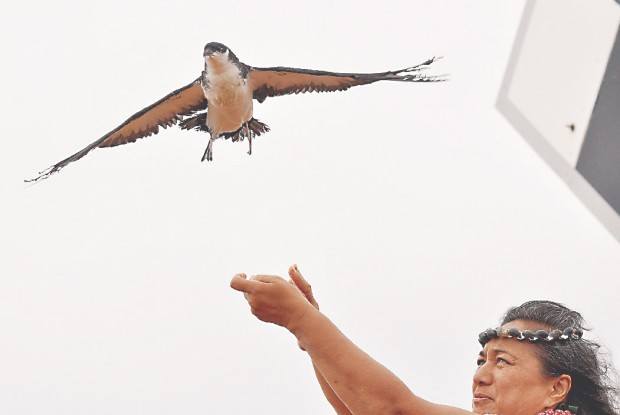LIHU‘E — In an attempt to save what remains of the dwindling population of rare native seabirds on Kaua‘i, conservationists have joined with cultural practitioners in a plan to sue Kaua‘i Island Utility Cooperative for its alleged continued violation of
LIHU‘E — In an attempt to save what remains of the dwindling population of rare native seabirds on Kaua‘i, conservationists have joined with cultural practitioners in a plan to sue Kaua‘i Island Utility Cooperative for its alleged continued violation of the Endangered Species Act.
The co-op’s “long-standing refusal to implement measures to protect Hawaiian petrel and Newell’s shearwater from fatal collisions” has been a “concern of ours” for years, said Maka‘ala Ka‘aumoana of Hui Ho‘omalu i Ka ‘Aina, one of four citizen groups threatening legal action.
“Collisions with KIUC’s power lines constitute the single largest source of seabird mortality from human activities on Kaua‘i,” states a press release sent by David Henkin, staff lawyer for Earthjustice, which is representing the groups.
In response to Wednesday’s notice of the intent to sue, KIUC said in a statement that its hold-up has been state and federal wildlife agencies’ delay in acting on the co-op’s applications regarding a Habitat Conservation Plan.
The local electric company is seeking an Incidental Take License and HCP to “minimize and avoid take” of the Hawaiian petrel (‘ua‘u), Newell’s shearwater (a‘o) and band-rumped storm-petrel and began a “new approach” approximately one year ago, according to KIUC’s release.
The state Department of Land and Natural Resources Division of Forestry and Wildlife and U.S. Fish and Wildlife Service are the government agencies tasked with deciding whether to grant authorization. The state recently completed the public review process, however, according to KIUC, the USFWS has “yet to start its separate public review process.”
“… We continue to urge the state and federal wildlife agencies to act on our long-standing applications,” KIUC’s release says.
Henkin said a “series of recommendations” — such as lowering power lines, attaching lines to bridges, switching from a vertical array of wires to a “traditional” T configuration and planting trees which shield lines — provided to Kaua‘i Electric in 1995 have yet to be taken up by KIUC.
Conducted by Electric Power Research Institute and funded by Kaua‘i Electric, the study identified several ways to curb seabird deaths which were occurring at a rate of 350 to 400 seabirds each year at the time, according to the Earthjustice press release.
Since then, Newell’s shearwater — found only in Hawai‘i, with Kaua‘i as their “anchor” — have declined in population by 75 percent, Henkin said.
“The study predicted if nothing were done, the birds would suffer dramatic decline,” Henkin said. “Unfortunately, the utility did not take it to heart” and have “not done what they needed to do.”
Approximately 200 birds are currently estimated to be killed annually by power lines, but the “difference is that there are fewer birds to kill,” Henkin said.
“We simply can’t afford to lose another 180 shearwaters each year,” said Peter Galvin of the Center for Biological Diversity in a press release.
In addition, the Endangered Species Act states that each violation of seabird take is subject to a fine of $50,000, Henkin said. “… KIUC could face millions of dollars in fines because of its illegal operations.”
KIUC has “implemented numerous measures” to preserve the species like “shielding thousands of streetlights, shielding facility lighting and altering power lines,” as well as funding the Save Our Shearwaters program, according to the KIUC press release.
“When KIUC took over Kaua‘i Electric in 2002, it should have had a plan to bring the company’s operations into compliance with the Endangered Species Act, just as it would provide for any other necessary infrastructure repair or upgrade,” said the American Bird Conservancy’s George Wallace in a press release.
Henkin agreed.
“For the last 15 years they’ve known exactly what to do, but have been shirking legal and moral responsibilities,” he said.
Earthjustice wants them to “ramp up their efforts” in “minimizing take to the maximum extent practicable.” And if money is an issue, the group is working on efforts to receive federal funding to begin “implementing some measures,” Henkin said.
“We’re doing what KIUC should’ve been doing all along, meeting with Hawai‘i’s congressional delegation to try to get federal funding to implement vitally needed conservation measures … so that they can be taken off the endangered species list,” said Conservation Council for Hawai‘i’s Don Heacock in a press release.
The birds are not only biologically important to Kaua‘i’s ecosystem, but are culturally important as well. Losing them from “the face of the earth” would be a travesty,” Henkin said.
“Since ancient times, Hawaiian fishermen have relied on the ‘a‘o to help them find fish,” said Kaua‘i fisherman Jeff Chandler of Hui Ho‘omalu i Ka ‘Aina in the press release. “They’re an important part of our culture. At the rate KIUC is going, the ‘a‘o could be totally wiped out.”
The ‘a‘o “spot the little fish” which, in turn, lead fishermen to the bigger fish, Ka‘aumoana said. These birds are the “key to traditional practitioners.”
“Like everyone, I’m concerned about my electricity bill, but it’s not pono for KIUC to ignore its kuleana to protect Kaua‘i’s native seabirds,” Chandler said.
Earthjustice, Hui Ho‘omalu i Ka ‘Aina, Conservation Council for Hawai‘i, the Center for Biological Diversity and the American Bird Conservancy aim to meet with KIUC to “figure out a reasonable, prompt schedule to put in place the measures the experts have identified as vital,” Henkin said. “It’s finally time for everyone to get together and figure out a way to cease ongoing slaughter of seabirds, otherwise we’re going to lose this national treasure forever.”


